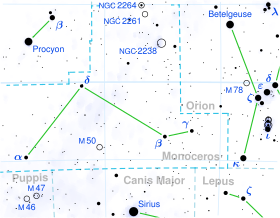
| |
| Observation data Epoch J2000 Equinox | |
|---|---|
| Constellation | Monoceros |
| ε Mon A | |
| Right ascension | 06 23 46.08471 |
| Declination | 4° 35′ 34.3153″ |
| Apparent magnitude (V) | 4.39 |
| ε Mon B | |
| Right ascension | 06 23 46.48292 |
| Declination | 4° 35′ 45.2307″ |
| Apparent magnitude (V) | 6.72 |
| Characteristics | |
| ε Mon A | |
| Spectral type | class = A5 IV |
| U−B color index | +0.14 |
| B−V color index | +0.20 |
| ε Mon B | |
| Spectral type | F5 V |
| U−B color index | −0.05 |
| B−V color index | +0.45 |
| Astrometry | |
| ε Mon A | |
| Radial velocity (Rv) | +13.10 km/s |
| Proper motion (μ) | RA: −22.06 mas/yr Dec.: +10.91 mas/yr |
| Parallax (π) | 26.67 ± 0.90 mas |
| Distance | 122 ± 4 ly (37 ± 1 pc) |
| Absolute magnitude (MV) | 1.52 |
| ε Mon B | |
| Radial velocity (Rv) | +12.40 km/s |
| Proper motion (μ) | RA: −21.86 mas/yr Dec.: +11.35 mas/yr |
| Parallax (π) | 26.95 ± 0.99 mas |
| Distance | 121 ± 4 ly (37 ± 1 pc) |
| Absolute magnitude (MV) | +3.88 |
| Details | |
| ε Mon A | |
| Mass | 2.04 M☉ |
| Radius | 2.5 R☉ |
| Luminosity | 25 L☉ |
| Surface gravity (log g) | 3.95 cgs |
| Temperature | 7,923 K |
| Metallicity | −0.11 dex |
| Rotational velocity (v sin i) | 149 km/s |
| ε Mon B | |
| Mass | 1.16 M☉ |
| Radius | 1.1 R☉ |
| Luminosity | 2.39 L☉ |
| Surface gravity (log g) | 3.95 cgs |
| Temperature | 7,923 K |
| Rotational velocity (v sin i) | 25 km/s |
| Other designations | |
| ε Mon, 8 Monocerotis, CCDM J06237+0436, WDS J06238+0436 | |
| ε Mon A: BD+04° 1236, FK5 244, GC 8240, HD 44769, HIP 30419, HR 2298, SAO 113810 | |
| ε Mon B: BD+04° 1237, FK5 244, GC 8241, HD 44770, HIP 30422, HR 2299, SAO 113811 | |
| Database references | |
| SIMBAD | data |
| SIMBAD | data |
ε Monocerotis, Latinised as Epsilon Monocerotis, is the Bayer designation of a binary star system in the equatorial constellation Monoceros. Its location is a guide for sky navigation toward the Rosette Nebula.
The white-hued primary component has a stellar classification of A5 IV, suggesting it is an aging subgiant star. Its apparent magnitude is 4.39 and it is approximately 122 light years away based on parallax. It is reportedly a spectroscopic binary with a period around 331 days.
The B component, at a separation of around 12.3", is a yellow-white hued F-type main-sequence star of class F5 V and an apparent magnitude of 6.72.
References
- ^ Van Leeuwen, F. (2007). "Validation of the new Hipparcos reduction". Astronomy and Astrophysics. 474 (2): 653–664. arXiv:0708.1752. Bibcode:2007A&A...474..653V. doi:10.1051/0004-6361:20078357. S2CID 18759600. Vizier catalog entry A Vizier catalog entry B
- ^ Anderson, E.; Francis, Ch. (2012). "XHIP: An extended hipparcos compilation". Astronomy Letters. 38 (5): 331. arXiv:1108.4971. Bibcode:2012AstL...38..331A. doi:10.1134/S1063773712050015. S2CID 119257644. Vizier catalog entry A Vizier catalog entry B
- ^ Hoffleit, D.; Warren, W. H. (1995). "VizieR Online Data Catalog: Bright Star Catalogue, 5th Revised Ed. (Hoffleit+, 1991)". VizieR On-line Data Catalog: V/50. Originally Published in: 1964BS....C......0H. 5050. Bibcode:1995yCat.5050....0H.
- ^ Mallama, A. (2014). "Sloan Magnitudes for the Brightest Stars". The Journal of the American Association of Variable Star Observers. 42 (2): 443. Bibcode:2014JAVSO..42..443M.Vizier catalog entry
- ^ Mermilliod, J. C. (2006). "VizieR Online Data Catalog: Homogeneous Means in the UBV System (Mermilliod 1991)". VizieR On-line Data Catalog: II/168. Originally Published in: Institut d'Astronomie. 2168. Bibcode:2006yCat.2168....0M.Vizier catalog entry
- ^ Gontcharov, G. A. (2006). "Pulkovo Compilation of Radial Velocities for 35 495 Hipparcos stars in a common system". Astronomy Letters. 32 (11): 759–771. arXiv:1606.08053. Bibcode:2006AstL...32..759G. doi:10.1134/S1063773706110065. S2CID 119231169.
- ^ Zorec, J.; Royer, F. (2012). "Rotational velocities of A-type stars". Astronomy & Astrophysics. 537: A120. arXiv:1201.2052. Bibcode:2012A&A...537A.120Z. doi:10.1051/0004-6361/201117691. S2CID 55586789. Vizier catalog entry
- ^ Allende Prieto, C.; Lambert, D. L. (1999). "Fundamental parameters of nearby stars from the comparison with evolutionary calculations: Masses, radii and effective temperatures". Astronomy and Astrophysics. 352: 555–562. arXiv:astro-ph/9911002. Bibcode:1999A&A...352..555A.
- ^ David, Trevor J.; Hillenbrand, Lynne A. (2015). "The Ages of Early-Type Stars: Strömgren Photometric Methods Calibrated, Validated, Tested, and Applied to Hosts and Prospective Hosts of Directly Imaged Exoplanets". The Astrophysical Journal. 804 (2): 146. arXiv:1501.03154. Bibcode:2015ApJ...804..146D. doi:10.1088/0004-637X/804/2/146. S2CID 33401607.
- Wu, Yue; Singh, H. P.; Prugniel, P.; Gupta, R.; Koleva, M. (2010). "Coudé-feed stellar spectral library – atmospheric parameters". Astronomy & Astrophysics. 525: A71. arXiv:1009.1491. Bibcode:2011A&A...525A..71W. doi:10.1051/0004-6361/201015014. S2CID 53480665.
- Kaler, James. "EPS MON (Epsilon Monocerotis)". STARS. University of Illinois. Retrieved 2017-12-23.
- ^ Mason, Brian D.; Wycoff, Gary L.; Hartkopf, William I.; Douglass, Geoffrey G.; Worley, Charles E. (2001). "The 2001 US Naval Observatory Double Star CD-ROM. I. The Washington Double Star Catalog". The Astronomical Journal. 122 (6): 3466. Bibcode:2001AJ....122.3466M. doi:10.1086/323920. Vizier catalog entry
| Constellation of Monoceros | |||||||||||||
|---|---|---|---|---|---|---|---|---|---|---|---|---|---|
| Stars |
| ||||||||||||
| |||||||||||||
| Star clusters |
| ||||||||||||
| Nebulae |
| ||||||||||||
| Galaxies |
| ||||||||||||